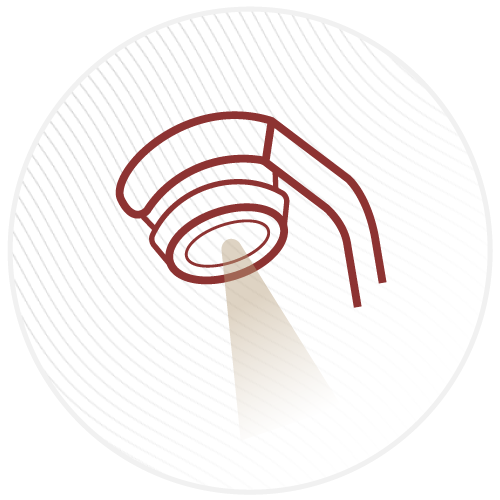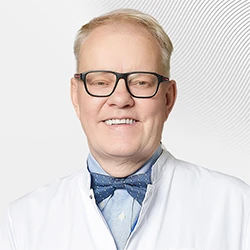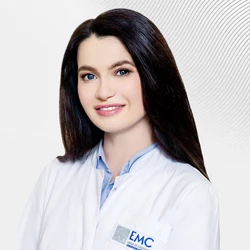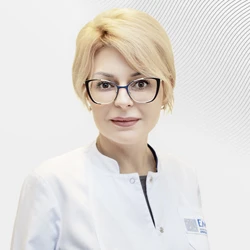Nasopharyngeal Cancer Treatment
In the EMC, a multidisciplinary council of doctors participates in making an accurate diagnosis. Among them are radiologists, oncologists, otorhinolaryngologists, and surgeons. Ophthalmologists and neurosurgeons can also join the discussion. If desired, the patient can request verification of his condition from the best specialists in the USA and Europe. Modern equipment makes it possible to effectively treat the disease at any stage without the risk of losing the patient's health and life.
If surgical treatment is necessary, an operation is performed in the EMC using a robot-assisted method. The DA Vinci Si HD system helps to perform surgery in a low-trauma way and remove the tumor without long-term rehabilitation after.
A complete victory over nasopharyngeal cancer without surgical intervention is possible at the European Medical Center.
Types of glioblastoma
With this method of treatment, the drug is selected based on molecular genetic tests, which allows for the most effective treatment for a particular case. In addition, this method allows you to act exclusively on the affected cells and not damage healthy ones.
In the course of targeted therapy, the use of Bevacizumab or Avastin has a particularly positive effect. The drug is administered through a venous catheter. It strikes the blood vessels that are involved in the formation of glioblastoma. As a result, the malignant cells are destroyed. Bevacizumab is most often used to control relapses.Advantages of targeted therapy in EMC
EMC is the only clinic that provides the most comprehensive genomic profiling service for the selection of targeted therapies. This method is also used in the fight against glioblastoma. EMC specialists compile a molecular genetic portrait of the tumor without obtaining a sample of its tissue: the patient's blood plasma is sufficient.
Stages of nasopharyngeal cancer
As with any cancer, the stages of nasopharyngeal cancer are determined depending on the size of the tumor and the degree of prevalence. The general classification for all types of cancer was created by the American Joint Committee on Cancer (AJCC) and the International Union Against Cancer (UICC). When studying a malignant tumor in nasopharyngeal cancer, the doctor evaluates the depth of its germination (T), the number of affected lymph nodes (N) and the formation of distant metastases (M). In the first and second stages, the patient can expect to make a full recovery with proper treatment. In the third and fourth stages, nasopharyngeal cancer metastasizes: first to neighboring areas (for example, to the lymph nodes of the neck), and then, in the absence of proper treatment, to any other (lungs, bones, brain, etc.). Taking these factors into account, doctors determine at which of the four stages cancer is diagnosed.
Nasopharyngeal cancer treatment
Nasopharyngeal cancer is a malignant neoplasm (carcinoma) that refers to tumors of the neck and head. This type of cancer develops behind the nasal cavity and above the soft palate. Squamous cell carcinoma, adenocarcinoma and other more rare histological subtypes are distinguished. If it is squamous cell carcinoma, the tumor develops from the mucous membrane. If it is an adenocarcinoma, then the cancer is formed from glandular tissue. Squamous cell carcinoma of the nasopharynx is most common — 9 out of 10 cases of diseases. Among the risk factors, the Epstein-Barr virus is in the first place (detected in 70%), smoking, alcohol abuse, prolonged contact with chemicals (for example, wood dust, leather dust and formaldehyde released by MDF). Malignant nasopharyngeal tumor usually develops at the age of 15-25 years and 50-60 years (double peak incidence), most often in men.
The treatment strategy for nasopharyngeal cancer is individual for each patient and depends on the structure of the tumor, its size, degree of prevalence, and the presence or absence of metastases. Nasopharyngeal cancer can be treated surgically (at the first stage and with small neoplasms), as well as with chemoradiotherapy (in all other cases). Targeted therapy is often used for cancer in the third and fourth stages.
Advantages of treatment in EMC



Operation
Surgery for nasopharyngeal cancer
Malignant tumor of the nasopharynx is operated on extremely rarely. This happens only if the tumor is very small and is noticed at the first stage.
If surgery is recommended for a patient with nasopharyngeal cancer, then in most cases the European Medical Center uses a robot-assisted method using the latest generation DA Vinci robot. The robotic system with micro-tools is operated by a doctor, who removes the tumor through small punctures. EMC is the only clinic in Russia that uses transoral surgery (TORS) to remove a tumor. The 3D image of the operated area with 10x magnification allows the surgeon to carry out the treatment in the most accurate way. This method is not as traumatic as open surgery, which means that the rehabilitation time is significantly reduced. In addition, it reduces the risk of excessive blood loss, which is an important factor for rapid recovery. This method does not involve large incisions on the skin, which, in turn, eliminates the appearance of visible scars.
- The possibility of using transoral surgery (TORS);
- Availability of a robot-assisted treatment method using the DA Vinci Si HD device;
- Operated by: a leading specialist in otorhinolaryngology specializing in Head and Neck Surgery, an otorhinolaryngologist-surgeon, Professor Millier Jean-Rene (France) and an otorhinolaryngologist-surgeon, doctor of the highest category, Doctor of Medicine, Professor Gennady Elkun.
Radiation therapy
Radiation therapy refers to non-surgical but radical methods of treating nasopharyngeal cancer. This method of fighting nasopharyngeal cancer is used more often than others. At the earliest stage (T1N0M0), such treatment is sufficient. If surgery and tumor removal are contraindicated for a patient, this does not mean that it cannot be completely cured. Radiation therapy can sometimes be more effective than surgery. The number of sessions for nasopharyngeal cancer is determined individually for each patient.
Before irradiating a malignant neoplasm, doctors perform an MRI and/or PET/CT scan, which visualizes the tumor and its contours. Markings are made based on these images and treatment is planned. The radiation sources are exposed in such a way that the gamma rays only hit the tumor area and adjacent tissues. This means that other organs will not be injured. Thus, in the treatment of nasopharyngeal cancer, it is extremely important that radiation does not damage the eyeball, brain and spinal cord, optic nerve junction, larynx, thyroid gland, lower jaw, temporomandibular joint, salivary glands, and temporal lobe of the brain. Radiation therapy fields and doses are selected individually for each patient, depending on the size of the tumor, its prevalence, and the presence of metastases.
Radiation treatment of cancer is performed at the Radiotherapy Center of the European Medical Center using a special technology called Image Guided Radiotherapy (IGRT). This is radiation therapy with visual image control. It is performed on the Varian EDGE device, which has no analogues in terms of exposure accuracy.
Chemotherapy
For nasopharyngeal cancer, the combination of radiation and chemotherapy is considered the gold standard of treatment worldwide. The number of sessions for each cancer patient is selected individually depending on the stage of the malignant tumor.
The European Medical Center collaborates with radiotherapists, surgeons, pathologists, molecular biologists, oncogeneticists to develop a personalized approach using artificial intelligence. This option is suitable for those patients whose disease is already beyond the standard capabilities.
Certified original drugs are used for treatment.
Targeted therapy
Improving the quality of life of patients with recurrent glioblastoma can be achieved by prescribing the targeted drug bevacizumab, which is a blocker of vascular endothelial growth factor and reduces the patient's need for dexamethasone.
The targeted drug attacks the blood vessels that are involved in the formation of glioblastoma.
Symptoms of nasopharyngeal cancer
Nasopharyngeal cancer is dangerous because it has no characteristic symptoms, and in the early stages of development this type of cancer does not manifest itself in any way. In most cases, carcinoma makes itself felt only in the third and fourth stages. Symptoms may include nasal discharge with an admixture of blood, stuffy ears, difficulty breathing through the nose, decreased sense of smell, hearing loss, and double vision. During the process of tumor growth and its spread, lymph nodes in the neck area increase in humans, and this condition does not go away within a month.
Diagnosis of nasopharyngeal cancer
Carcinoma is easily diagnosed on an outpatient basis. Often, the detection of a tumor occurs by chance. So, during an X-ray examination of the organs of the human head or skeleton, the doctor may notice shadows in the nasopharynx. If nasopharyngeal cancer is suspected, an endoscopic examination is performed, in which material is taken for a biopsy through the nose. If the diagnosis is confirmed, additional studies are prescribed in order to understand how far the tumor has spread. As a rule, these are positron emission computed tomography (PET-CT) and magnetic resonance imaging (MRI). These studies are important for drawing up a competent and effective plan to combat nasopharyngeal cancer.
Endoscopic examination
The doctor reaches the nasopharyngeal tumor using a special device (endoscope) and makes a puncture of the malignant neoplasm. This is the first stage that allows you to accurately diagnose nasopharyngeal cancer or exclude it altogether.
MRI
Magnetic resonance imaging in cancer is necessary in order to identify the exact location of the tumor and understand how far it has spread in the nasopharynx.
PET-CT
The European Medical Center has the opportunity to perform positron emission computed tomography for the diagnosis of nasopharyngeal cancer. One study combines two diagnostic methods at once, thanks to which it is possible to identify the exact contours of the tumor, the distant spread of cancer cells to the lymph nodes and other organs.
The cost of nasopharyngeal cancer treatment in EMC depends on the stage of the disease and methods of tumor control.
Why the EMC
The first and only clinic in Russia, created in the image of the world's leading clinics
EMC is a multidisciplinary center offering patients a high level of medical services and a personalized approach
Worldwide recognition and awards
 Learn more
Learn more
Worldwide recognition and awards
 Certificates and licenses
Certificates and licenses
Make an appointment for a consultation
Specify your contacts and we will contact you to clarify the details
Reviews
and new products of the EMC
.webp)








